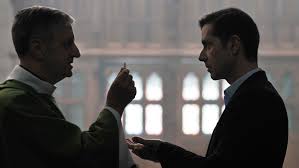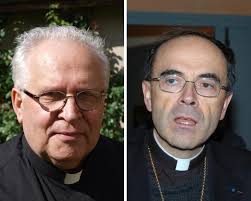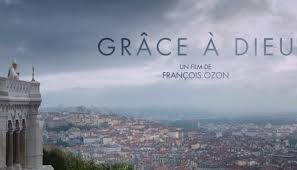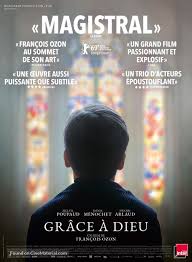CHALLENGE TO THE CATHOLIC CHURCH: GRACE a DIEU/ BY THE GRACE OF GOD
France, 2019, 137 minutes, Directed by François Ozon.

SIGNIS STATEMENT
World Catholic Association for Communication.
This very topical film, for the Church, the Churches and all institutions with cases of sexual abuse of minors. This is a French story from the 20th century but actual cases from 2014 in the city of Lyon: survivors, families, abusive priest and the case against Cardinal Paul Barberin of Lyon and his pastoral care.
Here is a text that has been circulated around the Church.
The first thing to say about François Ozon’s contribution to the cinema focusing on clerical sexual abuse is that it is quite a significant contribution. It is based on real-life characters, an abusive priest, Father Bernard Preynat, the Cardinal- Archbishop of Lyon, Barberin, lay assistants, and a number of men who raised issues from their past, their experiences of abuse, leading to criminal investigations into the priest. An epilogue indicates that no date for the trial has been set, although there has been work on the investigation for several years, and that the Cardinal and one of his lay assistants have been on trial for not passing on information about the abuse – on March 7th, the courts found the Cardinal guilty, an appeal has been entered.

Catholic consciousness about clerical sexual abuse has undergone quite some transformation in the last three decades, in some cultures much more developed than in others. The word used by many is that the Catholic response is evolving. And this film will contribute to the evolution. There are early references to Pope Francis and his stances about abuse, investigations by Cardinal O’ Malley for the Vatican, protocols changing concerning trials, priests being laicised, penalties, civil cases and imprisonment. This film, with its focus on serious misdeeds, insufficient response from hierarchy and authorities, is a helpful opportunity for Catholics (and members of other denominations who have experienced abuse as well as other institutions) to acknowledge the realities of the past, express regrets, move towards greater openness.
While Ozon focuses on one diocese and one priest, he highlights the events presented as something local and solitary, in comparison with many of the cases that have occurred in France. The screenplay scarcely acknowledges that there have been cases right throughout the world and for so long. We could be reminded that many other countries have been pursuing the issues of abuse, attempts to rectify situations honestly, acknowledge guilt since the 1990s.
Cases were raised in Canada in the 1980s and 1990s. The first protocols from the official church in Australia were published in 1996. In fact, Ireland has had a national investigation into abuse, Australia had a governmental Royal Commission into institutional abuse, with a thorough examination of the Catholic Church, from 2013 to 2018, with extensive airing by the media. Although the Oscar-winning film Spotlight, 2015, almost seems to indicate that the Americans discovered abuse and dealt with it in the media, their focus was on the years up to 2002. So, for outsiders to France, to see this case coming up in the middle of the second decade of the 21st century seems comparatively late – and it would have been interesting had the men in Lyon had contact with organisations in other countries.

This can be confirmed by the cinema history of films about clerical sexual abuse, the American film, Judgement, 1990, about cases in Louisiana, The Boys of St Vincent, 1992, quite forthright about Canadian cases, and a number of British and Irish films since 2000, and the miniseries from Australia, The Devil’s Playground, 2014. In fact, the film Our Fathers, 2005, was quite explicit in basing the screenplay on actual characters, survivors, lawyers, clergy, and quite specifically naming the Cardinal-Archbishop of Boston, Cardinal Bernard Law.
A note about the screenplay’s use of the word, ‘victim’. Another development over recent years, especially in some English-speaking countries, is the substitution of the word ‘survivor’ for ‘victim’. Victim highlights the perpetrator as well as the abused, while survivor highlights the life of the abused person (acknowledging that so many abused have committed suicide), a more positive perspective on going ahead with life.
As regards the film itself, it is very much a verbal film, voice-overs describing experiences, the texts of letters and emails, words of interviews, reports to the police, family discussions. This means that the director is able to be less detailed in visual representations of abuse situations, relying on the flashbacks, on the age and innocence of the child, the child being selected by the abuser, his taking the child away from the group. In this way, the director is able to avoid any prurient response to the story.
The film is also an effective in its principal focus being on the particular survivors, four of them, one, devoutly Catholic, wife and five children, discovering the offending priest is still in ministry, wanting to act, communicating with the archdiocese, going to interviews, even a meeting with the offending priest. But, with ecclesiastical delays, his growing more concerned and, approaching the police, setting a criminal investigation in process. Another man, now atheist, wife and children, has been moved into action because his mother wrote to the then Cardinal and other clergy in the early 1990s and has kept a file which the police use. This man has another friend who remembers abuse in the past, at the scout camp sponsored by the priest. The fourth man, high IQ but not able to fit into society so well, also joins the group which establishes a website, and an association as more and more survivors emerge.

Again, it would be interesting to compare the networks of survivors in other countries and how they operate, cooperate, and have been significant in giving witness into investigations, especially government investigations as in Ireland and Australia, for instance. This film gives the (perhaps unintended) impression that this website and network was a first in dealing with abusive clergy.
Ozon takes a fair perspective on the events and the characters. There is certainly criticism of the Cardinal, his hesitations, some contradictions in his testimony in press conferences. Worthy of note, is the Cardinal’s faux pas in responding to issues concerning the ending of statutes of limitations, God be thanked (Grace a Dieu), the title of the film. The Cardinal is challenged, acknowledges his loose use of words, apologises (and mistakes like this, unthought-out comments by the hierarchy, have plagued investigations and stirred media upset, flowing over for the public).
In fact, there has been great rage in many of the survivors, the years-long hurt and wounding, the disastrous effect on life, relationships, ability to cope and lead a fruitful life. However, this film has its protagonists angry but more objective, less raging but earnest for justice to be seen and justice to be done, possibilities for reparation, hesitations concerning forgiveness of the offender.
It is interesting that in this film, while there are some lawyers, they play subsidiary roles, different from lawyers’ work in more litigious cultures, with a focus on financial compensation, and a criticism of the church in using lawyers, legal action before expressions of compassion.

One of the directions for another film would be to take up the presentation of Father Preynat (for English-speaking audiences it is ominous that his surname begins with ’prey’, a man who was a prolific predator), his admitting his guilt and responsibility, his apologies to the survivors, but his acknowledgement of his psychological condition which needed much more attention, his attraction towards children, even seen in his emotional response to meeting the survivors, wanting their support and forgiveness, speaking affectionately (until reprimanded by the lawyer), his willingness to pray with the survivors, his affectionate smiles as he left the meetings. We need more probing of the characters, motivations, mental and emotional conditions of the abusers.
This is not a review of the film. That would go into the quality of the screenplay and the direction, the fine performances of the central characters, the relying on strong dialogue to communicate perspectives.
But, for audiences from other cultures, it is a dramatisation of historical and contemporary events, issues for survivors, challenges to churches, which must continue.
Peter Malone MSC for SIGNIS.
